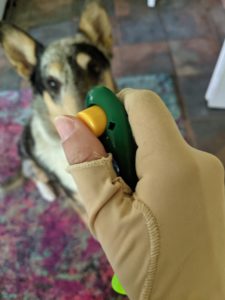Clicking, delivering treats, holding a leash, fastening a collar — all of these skills require hand strength and coordination. Many different disabilities can impact a person’s ability to use their hands. Some conditions like arthritis may cause pain and weakness. Neurological conditions may affect a person’s sensation, strength or ability to coordinate their hand movements. When a client’s disability limits the use of their hands, some creative accommodations may be needed for training.
- There are many different styles of clickers available, and clients may need to experiment to find the style that works best for their needs. In most cases, a larger clicker with a raised button is easier for clients with limited dexterity and coordination. Some clients may need to mark behavior with a verbal “yes” instead.
- Clients with limited strength or coordination of their fingers may need to press a clicker with their wrist or palm rather than their fingers. Another option that can help some individuals is to attach the clicker to adaptive equipment such as the armrest of a wheelchair.
- For many people with disabilities that impair their hands, larger treats are easier to handle than smaller ones. The texture of the treat itself can also make a difference. Encourage clients to experiment to find what works best for them.
- Tossing a treat, rather than delivering it directly to the dog, may be much easier for clients with hand limitations. Some service dog trainers do not toss treats to service dog candidates because they are afraid that doing so will encourage the dog to sniff the floor looking for crumbs while working in public access. It has been my experience that this can be avoided by employing simple training strategies. For example, service dogs can be taught a new marker word for treats that are tossed, such as “find it,” so the dog knows to look for treats on the ground. Read more about this hotly debated topic in the IAABC Journal.
- Food tubes or even some squeezable baby food (carefully selected to ensure that ingredients are safe) may be easier for clients to use than more typical training treats. Yet another option is for the client to offer the dog a lick of peanut butter or canned dog food on a long spoon.
- Treat pouches that have drawstrings are usually more challenging for clients than pouches that use magnetic closures. Larger openings can make it easier for the client as well. For some clients it may be best to use a cup or small bowl rather than a treat pouch.
- Choosing the right leash and collar can require some additional considerations. Experiment with different widths and types of clasps. If a client cannot use a clasp at all, another option is a martingale-style collar. The dog can be trained via luring or targeting to put their own head through the collar. There are a variety of different types of harnesses, including some that have magnetic closures, which may be easier for some clients to use.
It can be challenging to adapt training protocols to accommodate a client with limited use of their hands. However, in most cases there are alternatives that work very well. If you or your client are feeling frustrated, remember to focus on what the client is especially good at, and teach them training strategies that play to these strengths. For instance, if a client has a clear, steady speaking voice, teach them how to use a cheerful tone of voice to get and keep the dog’s attention in busy environments. It can be especially empowering to have your clients work with you to brainstorm the things they excel at, so you can come up with training modifications together. Your client’s healthcare team and rehabilitation professionals, like physical and occupational therapists, can be great resources for creative troubleshooting as well.

